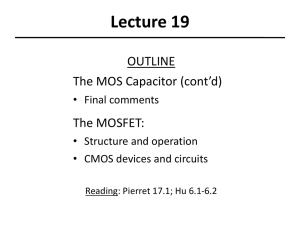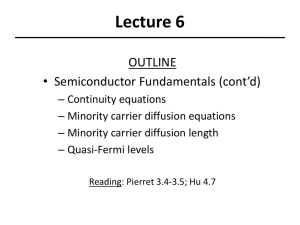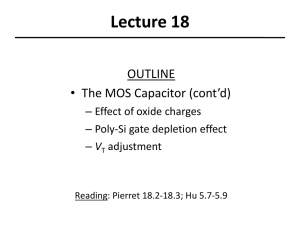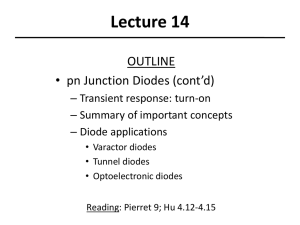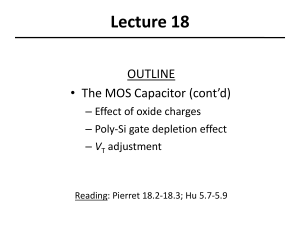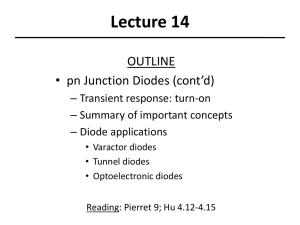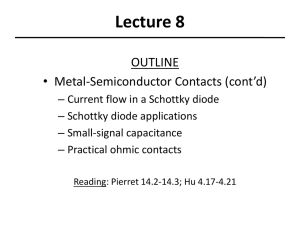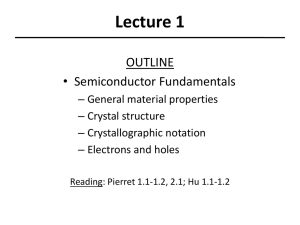Lecture 19
advertisement
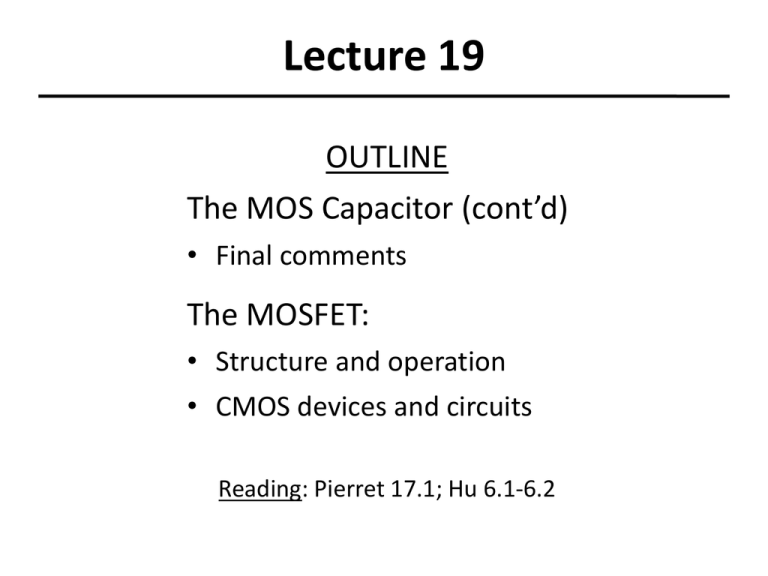
Lecture 19 OUTLINE The MOS Capacitor (cont’d) • Final comments The MOSFET: • Structure and operation • CMOS devices and circuits Reading: Pierret 17.1; Hu 6.1-6.2 Clarification: Effect of Interface Traps (c) (b) (a) “Donor-like” traps are charge-neutral when filled, positively charged when empty (a) Positive oxide charge causes C-V curve to shift toward left (more shift as VG decreases) (b) Traps cause “sloppy” C-V and also greatly degrade mobility in channel QIT (S ) VG Cox EE130/230M Spring 2013 Lecture 19, Slide 2 (c) Bias-Temperature Stress Measurement Used to determine mobile charge density in MOS dielectric (units: C/cm2) Na+ located at lower SiO2 interface reduces VFB VFB Na+ located at upper SiO2 interface no effect on VFB Positive oxide charge shifts the flatband voltage in the negative direction: VFB QF 1 MS Cox SiO2 QIT (S ) 0 xox ( x)dx Cox xo QM Cox VFB EE130/230M Spring 2013 Lecture 19, Slide 3 Invention of the Field-Effect Transistor In 1935, a British patent was issued to Oskar Heil. A working MOSFET was not demonstrated until 1955. EE130/230M Spring 2013 Lecture 19, Slide 4 Modern Field Effect Transistor (FET) • An electric field is applied normal to the surface of the semiconductor (by applying a voltage to an overlying electrode), to modulate the conductance of the semiconductor. Drift current flowing between 2 doped regions (“source” & “drain”) is modulated by varying the voltage on the “gate” electrode. EE130/230M Spring 2013 Lecture 19, Slide 5 The MOSFET Metal-Oxide-Semiconductor Field-Effect Transistor: GATE LENGTH, Lg OXIDE THICKNESS, Tox Intel’s 32nm CMOSFETs Gate Desired characteristics: • High ON current • Low OFF current Source Drain Substrate • “N-channel” & “P-channel” MOSFETs operate in a complementary manner “CMOS” = Complementary MOS EE130/230M Spring 2013 Lecture 19, Slide 6 CURRENT • Current flowing between the SOURCE and DRAIN is controlled by the voltage on the GATE electrode VT |GATE VOLTAGE| 6 N-channel vs. P-channel NMOS PMOS N+ poly-Si P+ poly-Si N+ N+ P+ p-type Si P+ n-type Si • For current to flow, VGS > VT • For current to flow, VGS < VT • Enhancement mode: VT > 0 • Enhancement mode: VT < 0 • Depletion mode: VT < 0 • Depletion mode: VT > 0 Transistor is ON when VG=0V EE130/230M Spring 2013 Lecture 19, Slide 7 Transistor is ON when VG=0V Enhancement Mode vs. Depletion Mode Enhancement Mode Depletion Mode Conduction between source and drain regions is enhanced by applying a gate voltage A gate voltage must be applied to deplete the channel region in order to turn off the transistor EE130/230M Spring 2013 Lecture 19, Slide 8 CMOS Devices and Circuits CIRCUIT SYMBOLS N-channel MOSFET P-channel MOSFET CMOS INVERTER CIRCUIT VOUT VDD S INVERTER LOGIC SYMBOL VDD D VIN D GND VOUT S 0 VDD VIN • When VG = VDD , the NMOSFET is on and the PMOSFET is off. • When VG = 0, the PMOSFET is on and the NMOSFET is off. EE130/230M Spring 2013 Lecture 19, Slide 9 “Pull-Down” and “Pull-Up” Devices • In CMOS logic gates, NMOSFETs are used to connect the output to GND, whereas PMOSFETs are used to connect the output to VDD. – An NMOSFET functions as a pull-down device when it is turned on (gate voltage = VDD) – A PMOSFET functions as a pull-up device when it is turned on (gate voltage = GND) VDD input signals EE130/230M Spring 2013 A1 A2 AN Pull-up network A1 A2 AN Pull-down network PMOSFETs only F(A1, A2, …, AN) Lecture 19, Slide 10 NMOSFETs only CMOS NAND Gate VDD A A 0 0 1 1 B F A B EE130/230M Spring 2013 Lecture 19, Slide 11 B 0 1 0 1 F 1 1 1 0 CMOS NOR Gate VDD A 0 0 1 1 A B F B EE130/230M Spring 2013 A Lecture 19, Slide 12 B 0 1 0 1 F 1 0 0 0 CMOS Pass Gate A Y X A EE130/230M Spring 2013 Lecture 19, Slide 13 Y = X if A
